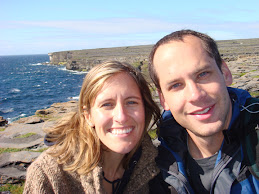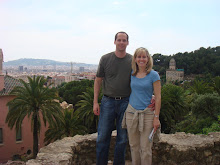

Lisbon is Europe's westernmost capital city and also supposedly the cheapest. The prices did not disappoint - just 39 cents for a jug of water that costs 2.50 euros back in Ireland. Everything about this city exceeded our expectations. The architecture was an ecclectic mix of Moorish (African and Middle Eastern Muslims who overtook Lisbon in the year 711), Spanish, French and Italian. This city has so much character, you have to see it to appreciate the diversity. And the weather was excellent - most days were sunny and 64-68 degrees. We had a little rain one morning, but that was about it. Another unforgettable trip with great weather.
The people were extremely friendly too. One bus driver gave us a free ride to the nearest tram station when we asked him for directions - definitely got our nod for nicest bus driver in Europe! Public transportation was convenient, cheap and safe - one-day pass good on the Metro, buses, tram and trolleys for only 3.50 euros - and you get to ride up in the famous street elevator on that ticket too.
Lisbon reminded us a lot of San Francisco, with its large bridges, trolley cars, hilly streets and beautiful river/sea views. (If you are having trouble seeing any of the slide.com pictures, just click on the X in the upper-right-hand corner of the Slide box. Their advertisements and sign-up screens are a pain in the butt. Sorry.)
Some of the sites we visited in Lisbon include:
The Rossio, one of the main squares in city centre where Damon took stunning night photos of the theatre and water fountains.
Praça do Comércio (Commerce Square), a large piazza near the water with stately canary-yellow symmetrical buildings around the parameter with a huge archway leading into the square.
We watched the Singing Chihuahua perform on Rua Augusta. Do click on this YouTube link to watch him sing. He did not disappoint.
Miradouro das Portas do Sol and Miradouro de Santa Luzia. Miradouros are several terraces and lookout points with vistas of the city.
The famous Santa Justa elevador (elevator), which we didn't wait in line to ride but walked up to the top and enjoyed sweeping views of the rooftops, castle and waterfront.
Santa Maria Maior de Lisboa (Sé de Lisboa), the cathedral of Lisbon, is the oldest church in the city. Construction of the cathedral began in 1147. The Cloisters there (2.50 euro entry) were stunning and well worth the nominal fee.
Alfama, the oldest district in Lisbon. We walked through the streets of Alfama on Friday (where we stopped and had lunch outside) and on Saturday (for a disappointing flea market). On Friday we stopped by the Castelo São Jorge in Alfama, but chose not to pay to go inside based on recommendations from other visitors.
We climbed to the top of the Padrão dos Descobrimentos monument and looked out over the city and River Tagus.
Torre de Belém (Belém Tower) was built both as a ceremonial gateway to Lisbon and as part of a defence system of the entrance of the Tagus river and the Jerónimos Monastery, which was necessary to protect Lisbon.
Mosteiro dos Jerónimos (Jeronimos Monastery) - Damon's top site in Lisbon - unbelieveable Cloisters.
One of the highlights of our trip for me was a visit to the São Vicente de Fora Monastery, where we enjoyed sweeping views of the city and River Tagus as well as stunning azulejos tiles throughout the hallways, stairwells and cloisters.
While in Lisbon we also learned about azulejo tiles and visited the National Museum of Azulejos, which allowed us to also see the ornate, gilded Convento da Madre de Deus church, now part of the museum. The azulejos are a typical form of Portuguese or Spanish painted, tin-glazed, ceramic tilework. They have become a typical aspect of Portuguese culture, manifesting without interruption during five centuries the consecutive trends in art.
Day Trip #1: Cascais and Sintra
Cascais, a coastal town 30 kilometres west of Lisbon, was recommended to us by wine writer Bob Ecker of Napa. It is a former fishing village with a harbor, charming shops, wonderful architecture, a castle (under renovation so we couldn't visit), Castro Guimaraes Palace and Farol Museu de Santa Marta(museum that looks like a villa perched on the rocks with a lighthouse nearby). The harbor, palace (with beautiful gardens) and nearby museum are pictured here.
Castelo dos Mouros (Castle of the Moors) is located on a hilltop overlooking the village of Sintra and is recognized as a World Heritage Site by UNESCO. The castle was originally built by the Moors, possibly between the 9th and 10th centuries. The steep and winding drive up the hill to the top was quite a ride.
The Pena National Palace (Palacio Nacional de Pena) was another highlight of our trip. The palace stands on the top of a hill above the town of Sintra, and on a clear day it can be easily seen from Lisbon and much of its metropolitan area. The palace is a UNESCO World Heritage Site and one of the Seven Wonders of Portugal. The architecture and grandness of the palace reminded us of Las Vegas or Walt Disney World...on steroids.
Day Trip #2: Alentejo (Reguengos de Monsaraz, Evora, Estremoz)
For our last day in Portugal, we drove to the Alentejo region to sample its wines and visit a few of the historic villages.
We first stopped at Herdade do Esporão in Reguengos de Monsaraz, had a wine tasting and took a jeep ride through the vineyards. The winery is known for its historic tower and had a beautiful lake, but it was a little farther southeast than we expected (about 35 minutes from Evora).
We then spent a few hours walking through the walled village of Évora, a UNESCO World Heritage Site, where we also stopped for lunch at an outdoor cafe.
That afternoon, we enjoyed an insightful tour at J. Portugal Ramos winery near the village of Estremoz, then walked around the castle and church near the top of Estremoz before heading back to Lisbon.
I don't think I could go a lifetime without visiting Lisbon again. It's a special place and one that is already calling me to return.




























